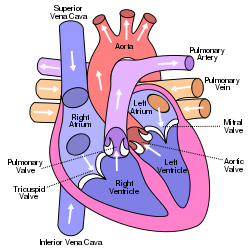Mitral regurgitation surgery: Difference between revisions
| Line 8: | Line 8: | ||
==[[Mitral regurgitation surgery overview|Overview]]== | ==[[Mitral regurgitation surgery overview|Overview]]== | ||
==[[Mitral regurgitation surgery indications|Indications]]== | ==[[Mitral regurgitation surgery indications|Indications]]== | ||
Revision as of 16:42, 23 September 2011
|
Mitral regurgitation surgery | |
|
Treatment | |
|---|---|
|
Mitral regurgitation surgery On the Web | |
|
American Roentgen Ray Society Images of Mitral regurgitation surgery | |
|
Directions to Hospitals Performing Mitral regurgitation surgery | |
|
Risk calculators and risk factors for Mitral regurgitation surgery | |
For the WikiPatient page for this topic, click here
For the main page of mitral regurgitation, click here
Editor-In-Chief: C. Michael Gibson, M.S., M.D. [1]; Associate Editor(s)-In-Chief: Mohammed A. Sbeih, M.D. [2]; Cafer Zorkun, M.D., Ph.D. [3]; Varun Kumar, M.B.B.S.; Lakshmi Gopalakrishnan, M.B.B.S.

Overview
Indications
Preoperative Evaluation
Procedure
Recovery
Outcomes & Prognosis
Complications
Videos
External links
http://en.wikipedia.org/wiki/Mitral_valve#cite_note-0
http://www.nlm.nih.gov/medlineplus/ency/article/000176.htm
http://www.nhlbi.nih.gov/health/health-topics/topics/hs/before.html
http://www.mayoclinic.org/mitral-valve-disease/
http://www.nlm.nih.gov/medlineplus/ency/article/007411.htm
http://www.nhlbi.nih.gov/health/health-topics/topics/hs/during.html
http://www.nhlbi.nih.gov/health/health-topics/topics/hs/after.html